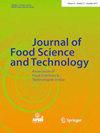AISI 304不锈钢表面低能量镀银及对肠炎沙门氏菌和单核增生李斯特菌的抑菌效果
IF 3.3
3区 农林科学
Q2 FOOD SCIENCE & TECHNOLOGY
引用次数: 1
摘要
银具有抗菌性能,当镀在不锈钢表面时,可以灭活微生物,从而防止生物膜的形成和食品的交叉污染。因此,在本研究中,我们评估了低能量剂量注入AISI 304不锈钢表面的银离子对肠炎沙门氏菌和单核细胞增生李斯特菌这两种食源性病原体的抗菌性能。采用2 keV和4 keV的能量对AISI 304不锈钢片进行了镀银处理,并对其剂量分布进行了模拟。将含银离子的样品分别感染肠炎沙门氏菌和单核增生乳杆菌,在25℃下孵育1 h和24 h。结果表明,4种keV处理对肠炎沙门氏菌有抑制作用,但对单核增生乳杆菌没有抑制作用。然而,2 keV处理显示出病原体的显著减少,并且2 keV能量处理的表面深度分布显示,3.5×10银原子/cm2植入到距不锈钢表面5nm处。用低能量剂量在不锈钢上植入银,显示出对食源性病原体的抗菌性能,这种策略可用于减少食品工业中粘附细胞和生物膜的形成。本文章由计算机程序翻译,如有差异,请以英文原文为准。
Silver implantation on AISI 304 stainless steel surface using low-energy doses and the antimicrobial effect against Salmonella Enteritidis and Listeria monocytogenes
Silver has antimicrobial properties and when implemented on the stainless steel surface can inactivate microorganisms and consequently prevent biofilm formation and cross-contamination of food. Therefore, in this study we evaluated the antibacterial properties of silver ions implanted on AISI 304 stainless steel surfaces using low-energy doses against Salmonella Enteritidis and Listeria monocytogenes, two foodborne pathogens. AISI 304 stainless steel coupons were treated using energy of 2 and 4 keV for silver implantation and simulations were performed to estimate its dose distribution. Coupons containing silver ions were contaminated with S. Enteritidis and L. monocytogenes and incubated at 25 °C for 1 and 24 h. Results demonstrated that 4 keV treatment were able to reduce S. Enteritidis, but not L. monocytogenes. However, the 2 keV treatment showed significant reductions of both pathogens and the depth profiles of surfaces treated with 2 keV of energy showed 3.5×10 silver atoms/cm2 implanted in up to 5 nm from the stainless steel surface. Silver implanted on stainless steel using low-energy doses demonstrated antimicrobial properties against foodborne pathogens and this strategy can be used to reduce adhered cells and biofilm formation in food industries.
求助全文
通过发布文献求助,成功后即可免费获取论文全文。
去求助
来源期刊
CiteScore
7.70
自引率
0.00%
发文量
274
审稿时长
11 months
期刊介绍:
The Journal of Food Science and Technology (JFST) is the official publication of the Association of Food Scientists and Technologists of India (AFSTI). This monthly publishes peer-reviewed research papers and reviews in all branches of science, technology, packaging and engineering of foods and food products. Special emphasis is given to fundamental and applied research findings that have potential for enhancing product quality, extend shelf life of fresh and processed food products and improve process efficiency. Critical reviews on new perspectives in food handling and processing, innovative and emerging technologies and trends and future research in food products and food industry byproducts are also welcome. The journal also publishes book reviews relevant to all aspects of food science, technology and engineering.

 求助内容:
求助内容: 应助结果提醒方式:
应助结果提醒方式:


